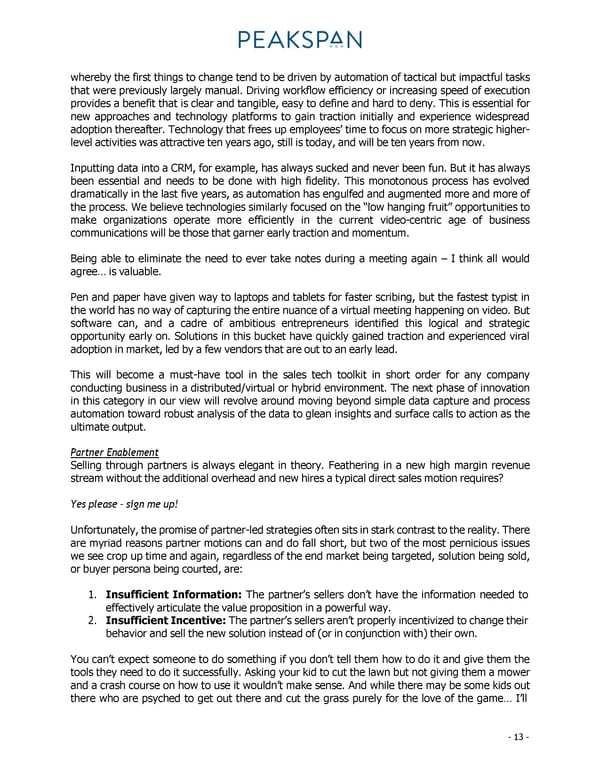whereby the first things to change tend to be driven by automation of tactical but impactful tasks that were previously largely manual. Driving workflow efficiency or increasing speed of execution provides a benefit that is clear and tangible, easy to define and hard to deny. This is essential for new approaches and technology platforms to gain traction initially and experience widespread adoption thereafter. Technology that frees up employees’ time to focus on more strategic higher- level activities was attractive ten years ago, still is today, and will be ten years from now. Inputting data into a CRM, for example, has always sucked and never been fun. But it has always been essential and needs to be done with high fidelity. This monotonous process has evolved dramatically in the last five years, as automation has engulfed and augmented more and more of the process. We believe technologies similarly focused on the “low hanging fruit” opportunities to make organizations operate more efficiently in the current video-centric age of business communications will be those that garner early traction and momentum. Being able to eliminate the need to ever take notes during a meeting again – I think all would agree… is valuable. Pen and paper have given way to laptops and tablets for faster scribing, but the fastest typist in the world has no way of capturing the entire nuance of a virtual meeting happening on video. But software can, and a cadre of ambitious entrepreneurs identified this logical and strategic opportunity early on. Solutions in this bucket have quickly gained traction and experienced viral adoption in market, led by a few vendors that are out to an early lead. This will become a must-have tool in the sales tech toolkit in short order for any company conducting business in a distributed/virtual or hybrid environment. The next phase of innovation in this category in our view will revolve around moving beyond simple data capture and process automation toward robust analysis of the data to glean insights and surface calls to action as the ultimate output. Partner Enablement Selling through partners is always elegant in theory. Feathering in a new high margin revenue stream without the additional overhead and new hires a typical direct sales motion requires? Yes please – sign me up! Unfortunately, the promise of partner-led strategies often sits in stark contrast to the reality. There are myriad reasons partner motions can and do fall short, but two of the most pernicious issues we see crop up time and again, regardless of the end market being targeted, solution being sold, or buyer persona being courted, are: 1. Insufficient Information: The partner’s sellers don’t have the information needed to effectively articulate the value proposition in a powerful way. 2. Insufficient Incentive: The partner’s sellers aren’t properly incentivized to change their behavior and sell the new solution instead of (or in conjunction with) their own. You can’t expect someone to do something if you don’t tell them how to do it and give them the tools they need to do it successfully. Asking your kid to cut the lawn but not giving them a mower and a crash course on how to use it wouldn’t make sense. And while there may be some kids out there who are psyched to get out there and cut the grass purely for the love of the game… I’ll - 13 -
 Sales Tech Thought Map Series Page 13 Page 15
Sales Tech Thought Map Series Page 13 Page 15
